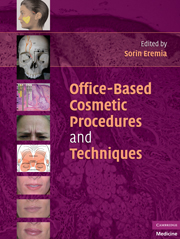Book contents
- Frontmatter
- Contents
- PREFACE
- CONTRIBUTORS
- PART ONE ANATOMY AND THE AGING PROCESS
- PART TWO ANESTHESIA AND SEDATION FOR OFFICE COSMETIC PROCEDURES
- Chap. 2 LOCAL ANESTHETICS
- Chap. 3 THE CONCEPT OF TUMESCENT ANESTHESIA
- Chap. 4 NERVE BLOCKS
- Chap. 5 TOPICAL ANESTHESIA
- PART THREE FILLERS AND NEUROTOXINS
- PART FOUR COSMETIC APPLICATIONS OF LIGHT, RADIOFREQUENCY, AND ULTRASOUND ENERGY
- PART FIVE OTHER PROCEDURES
- INDEX
- References
Chap. 5 - TOPICAL ANESTHESIA
from PART TWO - ANESTHESIA AND SEDATION FOR OFFICE COSMETIC PROCEDURES
Published online by Cambridge University Press: 06 July 2010
- Frontmatter
- Contents
- PREFACE
- CONTRIBUTORS
- PART ONE ANATOMY AND THE AGING PROCESS
- PART TWO ANESTHESIA AND SEDATION FOR OFFICE COSMETIC PROCEDURES
- Chap. 2 LOCAL ANESTHETICS
- Chap. 3 THE CONCEPT OF TUMESCENT ANESTHESIA
- Chap. 4 NERVE BLOCKS
- Chap. 5 TOPICAL ANESTHESIA
- PART THREE FILLERS AND NEUROTOXINS
- PART FOUR COSMETIC APPLICATIONS OF LIGHT, RADIOFREQUENCY, AND ULTRASOUND ENERGY
- PART FIVE OTHER PROCEDURES
- INDEX
- References
Summary
The development of topical anesthetics began with the description of topical cocaine in the nineteenth century. However, it took many decades to develop safe, effective topical anesthetics. An ideal agent would provide rapid, complete anesthesia for a short period of time, while being free of local or systemic side effects. With the increasing number of laser and surgical skin procedures being developed and performed, the need for and use of topical anesthetics have grown steadily. More recent advances, including eutectic mixtures and liposomal membranes, have led to the availability of multiple effective local anesthetics.
PHARMACOLOGY, METABOLISM, AND ABSORPTION
Topical anesthetics comprise three main components: an aromatic ring, an intermediate ester or amide linkage, and a tertiary amine. The amide anesthetics have an amide linkage, whereas the ester anesthetics have an ester linkage between the intermediate chain and aromatic ring. The amide anesthetics are metabolized by microsomal enzymes in the liver, whereas ester anesthetics are primarily metabolized by plasma cholinesterase.
The sensation of pain relies on neural transmission. Electrical stimuli are transmitted along nerve fibers via an ionic gradient based on differential electrolyte concentrations between intracellular (low Na+, high K+) and extracellular (high Na+, low K+) fluid. Without stimuli, the outer membrane is positively charged relative to the intracellular environment due to the action of the Na+/K+ adenosine triphosphatase pump as well as the outer membrane's poor permeability to Na+ ions.
- Type
- Chapter
- Information
- Office-Based Cosmetic Procedures and Techniques , pp. 23 - 26Publisher: Cambridge University PressPrint publication year: 2010



